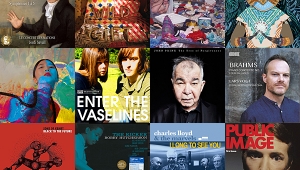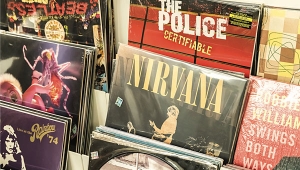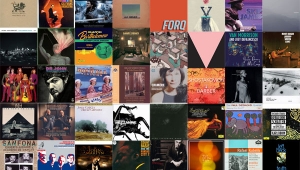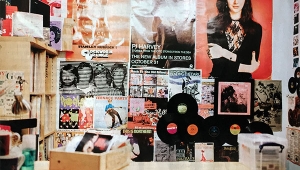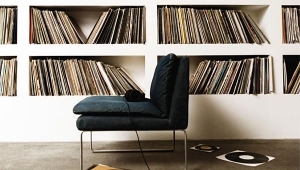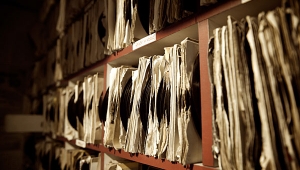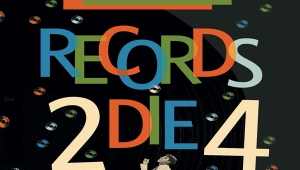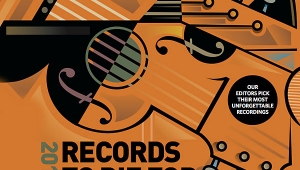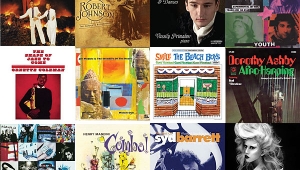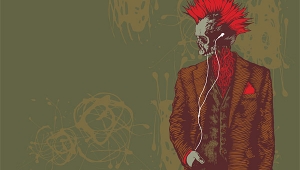| Columns Retired Columns & Blogs |
2000 Records to Die For Page 10
Kalman Rubinson
MAHLER: Symphony 9
With Commentary Disc by Benjamin Zander
Benjamin Zander, Philharmonia Orchestra
Telarc 3CD-80527 (CD). 1999. Robert Woods, David St. George, prods.; Adam Philip, eng. DDD. TT: 87:02 (Commentary disc: 76:42)
While there's still a lot of time left, this magnificent recording is an appropriate millennial nominee for "R2D4." First, the Ninth is Mahler's final completed symphonic statement on fate and human existence, and, at the end of his century, there is not yet a more trenchant musical commentary. Second, this recording represents the first release with a large independent label and a major orchestra by Benjamin Zander, an American conductor who is becoming a premier interpreter of symphonic music. Third, the recording of the symphony is accompanied by Zander's illuminating guide to performing and listening to the Ninth. Finally and, without doubt, most important, this is a moving and soul-shattering performance.
DICK CARY'S TUESDAY NIGHT FRIENDS: Catching Up
Directed by Dick Hamilton
Klavier KD-77024 (CD). 1999. Jim Turner, prod.; Dick Hamilton, eng.; Bruce Leek, mastering. DDD? TT: 68:30
I would not have picked this one off the record shelves. I had never heard of Dick Cary until Klavier sent this to me, and now I'm amazed. Dick Cary, termed a "musical centipede" by a Swedish journalist, produced over 3200 arrangements—performed on piano, trumpet, and alto horn on more than 100 Dixieland jazz recordings—and still found the inspiration to compose more than 1800 original works. Following his passing in 1994, "this recording is an attempt to 'catch up' with the remarkable Dick Cary—a musician's musician," and, while it may be an homage, it is also infectious and delightful.
ELIADES OCHOA Y EL CUARTETO PATRIA: Sublime Illusion
EMD/Higher Octave B00000 JGCD (CD). 1999. John Wooler, prod.; Clark Germain, eng. DDD? TT: 57:15PASCAL COMELADE: Haikus de Pianos
Eva wwcx 2038(CD). 1992. Pascal Comelade, Gereard Nguyen, prods.; François Dietz, eng. AAD? TT: 34:46
Lately I've been thinking a lot about time. Living in reunified Germany, I'm acutely aware that one aspect that separates the collective life experience of people from the western and eastern parts of Germany is the perception of time. Easterners used to live a slow life in which change was subtle and gradual: the same cars were produced on the same machines and painted in the same colors for decades, making for an extremely stable visual environment. The same was true of clothes, advertising for eastern brands of goods, etc. Personal lives, too, were stable: many workers never left the companies where they got their first jobs. Only the divorce rate was slightly higher than in Western Germany; women mostly had their own jobs, so were not held back in unfulfilling relationships by economic dependence. But in Western Germany as in the US, the pace of life has been subjectively accelerating since the '60s. So, in more senses than one, reunification has meant bringing the Eastern part of Germany up to speed.
RUN LOLA RUN: Original Soundtrack Recording
Music by Tom Tykwer
TVT Soundtrax 8220-2 (CD). 1999. Tom Tykwer, prod.; Johnny Klimek, eng.; Reinhold Heil, mix. DDD. TT: 77:19
Techno Art of Noise marries Morcheeba as David Lynch and Angelo Badalamenti give away the bride under the watchful eye of a moody German director thrown in just for laughs.There's definitely some primeval connection between sound and emotion, and every time I listen to this recording, I feel it deep. It vividly recalls the experience of seeing the film, which is just as utterly compelling as the music. Powerful driving bass, a wonderful and engaging midrange that physically pulls me into the music, with gorgeous highs beckoning seductively from above—always an immersive and goosebump-inducing listening experience. Commercial releases should all sound this good.
KRUDER DORFMEISTER: The K&D Sessions
Studio K7! K7073 (2 CDs). 1999. William Orbit, prod. DDD. TT: 2:06:51
Incredible—I love this two-CD set. Kruder and Dorfmeister are a couple of very cutting-edge and very talented mixmasters working out of Berlin. Their music'n'mixin' is beyond reproach for anyone who likes an easy, flowing, sensual, and rhythmic trip-hop/electronica/dance/dub kinda vibe. It's very international, with English, German, and French lyrics peppered throughout. I'm listening to it now on my office system, and I can't stop my head and upper body from noddin' and groovin' along with the beat. The flow, the connectivity, the easy but interesting musical exploration take me far and wide in my imagination. It's so easy to fall into the hypnotic, compelling, utterly attractive flow of sound. It's easy to take, but it's real music at the same time. I fear I'll overplay these CDs and lose interest, but I keep playing them, and continue to find them as fascinating and fresh as the day I found them at Etherea in the East Village.
MAHLER: Symphony 9
With Commentary Disc by Benjamin Zander
Benjamin Zander, Philharmonia Orchestra
Telarc 3CD-80527 (CD). 1999. Robert Woods, David St. George, prods.; Adam Philip, eng. DDD. TT: 87:02 (Commentary disc: 76:42)
While there's still a lot of time left, this magnificent recording is an appropriate millennial nominee for "R2D4." First, the Ninth is Mahler's final completed symphonic statement on fate and human existence, and, at the end of his century, there is not yet a more trenchant musical commentary. Second, this recording represents the first release with a large independent label and a major orchestra by Benjamin Zander, an American conductor who is becoming a premier interpreter of symphonic music. Third, the recording of the symphony is accompanied by Zander's illuminating guide to performing and listening to the Ninth. Finally and, without doubt, most important, this is a moving and soul-shattering performance.
My introduction to the Mahler 9 was Bruno Walter's NYP recording; Zander achieves a similar engrossing continuity, and with a much wider dynamic and expressive range. Bernstein/Concertgebouw, my standard, treads dangerously close to fervent excess. But while Bernstein forcefully pulls the listener along, Zander's balance creates an even greater momentum. Instead of transitions, one feels an inexorable progression of intensity that, ultimately, leaves one enervated but clarified.
The Philharmonia performs heroically, providing the execution one missed in Zander's otherwise fascinating earlier recordings. Telarc's transcription from the public performance and dress rehearsal at the Barbican Centre is better than Teldec's Inbal series with the Philharmonia, and very much as I remember the orchestra sounding in concert. A bit of reticence in the treble is noted, but, if memory serves, is somewhat welcome; and the dynamic range, matching the emotional one, is staggering.
DICK CARY'S TUESDAY NIGHT FRIENDS: Catching Up
Directed by Dick Hamilton
Klavier KD-77024 (CD). 1999. Jim Turner, prod.; Dick Hamilton, eng.; Bruce Leek, mastering. DDD? TT: 68:30
I would not have picked this one off the record shelves. I had never heard of Dick Cary until Klavier sent this to me, and now I'm amazed. Dick Cary, termed a "musical centipede" by a Swedish journalist, produced over 3200 arrangements—performed on piano, trumpet, and alto horn on more than 100 Dixieland jazz recordings—and still found the inspiration to compose more than 1800 original works. Following his passing in 1994, "this recording is an attempt to 'catch up' with the remarkable Dick Cary—a musician's musician," and, while it may be an homage, it is also infectious and delightful.
The tightly knit swing band performs 12 Cary originals and three arrangements, many of which, to my great surprise, are quite familiar: "The Albatross," "Black and Blue," "December Song," "Sea of Cortez," etc. But I didn't know I knew them, probably because they've never grabbed me and really forced me to tap my toes before. The solos, fully attributed in the notes, are perfectly inflected variations and comments on the melodies. Most delectable, and wonderfully apparent on "Recado," is the interplay of rhythms that Cary wove into these arrangements. Everything seems so natural and so right.
The sound is rich and detailed, with every instrument given an appropriate presence but not a spotlight. For example, I love the brrrr of the brass, but I never lose the sense that this is a cohesive ensemble. There's good balance and weight, too, although I would have liked a little more tightness and delineation in the bass.
![]()
Markus Sauer
ELIADES OCHOA Y EL CUARTETO PATRIA: Sublime Illusion
EMD/Higher Octave B00000 JGCD (CD). 1999. John Wooler, prod.; Clark Germain, eng. DDD? TT: 57:15PASCAL COMELADE: Haikus de Pianos
Eva wwcx 2038(CD). 1992. Pascal Comelade, Gereard Nguyen, prods.; François Dietz, eng. AAD? TT: 34:46
Lately I've been thinking a lot about time. Living in reunified Germany, I'm acutely aware that one aspect that separates the collective life experience of people from the western and eastern parts of Germany is the perception of time. Easterners used to live a slow life in which change was subtle and gradual: the same cars were produced on the same machines and painted in the same colors for decades, making for an extremely stable visual environment. The same was true of clothes, advertising for eastern brands of goods, etc. Personal lives, too, were stable: many workers never left the companies where they got their first jobs. Only the divorce rate was slightly higher than in Western Germany; women mostly had their own jobs, so were not held back in unfulfilling relationships by economic dependence. But in Western Germany as in the US, the pace of life has been subjectively accelerating since the '60s. So, in more senses than one, reunification has meant bringing the Eastern part of Germany up to speed.
The western world has its own unease about the accelerated lives we force ourselves to lead. Milan Kundrea's The Discovery of Slowness has been a bestseller in a number of countries; trip-hop music has been a hugely successful counterpoint to the accelerated beat of modern dance-music styles. People are becoming aware that life has a rhythm, that different cultures have different rhythms, and that there will be times when the rhythm of one's own culture is not the rhythm that one's soul needs. And, of course, age plays a role: the obsession with speed and the obsession with youth are interrelated.
Which may partly explain why old men from Cuba have been such a hit with music audiences in the West: their music radiates a different concept of time. Buena Vista Social Club, one of my 1998 "R2D4" selections, has recently spent several weeks at the top of the German pop charts, thanks to Wim Wenders' film of the same name. The album has spawned a number of spin-offs and follow-ups, but the best recent addition seems to me to be this album by Eliades Ochoa, a member of the Buena Vista grouping. His mastery of different styles of Cuban music is perfect, his guitar technique flawless; even when notes fly thick and fast, he sounds relaxed and in control. His band is tight, the guest musicians (including Ry Cooder on the closing track) adding variety without diluting the spirit of this masterful record: joy, maturity, serenity, and confidence. (XXII-11)
My second choice is very different musically, but it, too, disorients the listener time-wise, and in a positive way. A Japanese haiku seeks the most succinct and elegant expression of a thought. Pascal Comelade is a French jazz musician whose Haikus de Pianos appears on a Japanese label, appropriately enough. He goes to the heart of the music you know in a very different context, stripping it of artifice, often slowing it down and revealing its substance. For example, the riff from Deep Purple's "Smoke on the Water," played on a toy piano, surprises with its fragile beauty. Comelade's original compositions combine elements of French folklore imaginaire, jazz, classical music, and pop. A record that warms your heart in winter and refreshes in summer.
![]()
Jonathan Scull
RUN LOLA RUN: Original Soundtrack Recording
Music by Tom Tykwer
TVT Soundtrax 8220-2 (CD). 1999. Tom Tykwer, prod.; Johnny Klimek, eng.; Reinhold Heil, mix. DDD. TT: 77:19
Techno Art of Noise marries Morcheeba as David Lynch and Angelo Badalamenti give away the bride under the watchful eye of a moody German director thrown in just for laughs.There's definitely some primeval connection between sound and emotion, and every time I listen to this recording, I feel it deep. It vividly recalls the experience of seeing the film, which is just as utterly compelling as the music. Powerful driving bass, a wonderful and engaging midrange that physically pulls me into the music, with gorgeous highs beckoning seductively from above—always an immersive and goosebump-inducing listening experience. Commercial releases should all sound this good.
Recorded in Germany and the States, with Bernie Grundman working his usual mastering magic. Just before the three-minute mark, listen for a bass crescendo that begins its rise through to a stunning sonic boom at around 3:54. The "instructions" read as follows: "Track 1, 'Believe,' is the essence of the Run Lola Run soundtrack. To re-experience the movie, listen to tracks 2-9. For an alternative experience, listen to tracks 10-16. Enjoy!" There's even a bonus track not heard in the film. It's the pounding, international alternate-take universe, erotic and bursting with the creative energy of the 21st century come to call at your door. Open up with welcoming arms, you'll love it.
KRUDER DORFMEISTER: The K&D Sessions
Studio K7! K7073 (2 CDs). 1999. William Orbit, prod. DDD. TT: 2:06:51
Incredible—I love this two-CD set. Kruder and Dorfmeister are a couple of very cutting-edge and very talented mixmasters working out of Berlin. Their music'n'mixin' is beyond reproach for anyone who likes an easy, flowing, sensual, and rhythmic trip-hop/electronica/dance/dub kinda vibe. It's very international, with English, German, and French lyrics peppered throughout. I'm listening to it now on my office system, and I can't stop my head and upper body from noddin' and groovin' along with the beat. The flow, the connectivity, the easy but interesting musical exploration take me far and wide in my imagination. It's so easy to fall into the hypnotic, compelling, utterly attractive flow of sound. It's easy to take, but it's real music at the same time. I fear I'll overplay these CDs and lose interest, but I keep playing them, and continue to find them as fascinating and fresh as the day I found them at Etherea in the East Village.
The recording is audiophile in every way: The encompassing bass creates a powerful foundation over a lush'n'lovely midrange and sweet highs with lots of detail. I don't know about the majors, but the recording values of these new-music recording houses popping up in lower Manhattan are right up there with the best. The soundstage, artificial though it may be, wraps way around the listener—so very involving. Open a bottle of champagne or a good vintage wine, plop either disc in the player, and stare deeply and meaningfully at your Love Interest of the Moment. I absolutely guarantee you a fluid, sexy, groovin' good time.
- Log in or register to post comments

